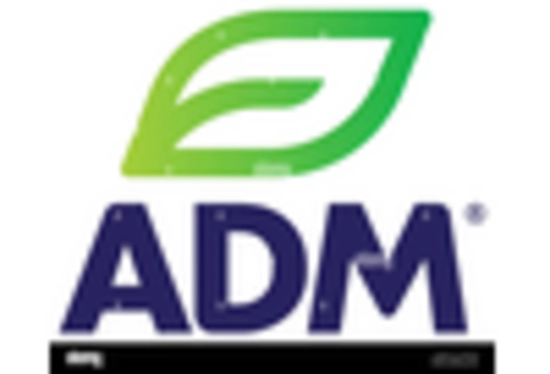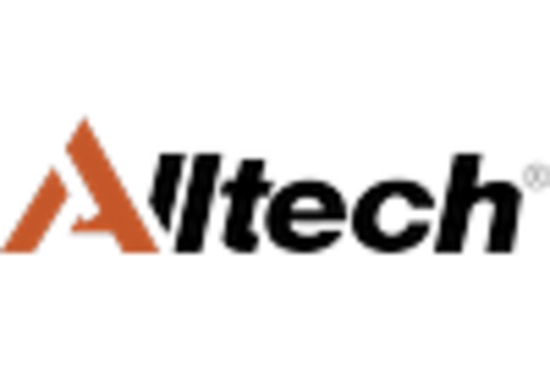-
Executive Summary
-
Scope of the Report
-
Market Definition
-
Scope of the Study
- Research Objectives
- Assumptions & Limitations
-
Markets Structure
-
Market Research Methodology
-
Research Function
-
Secondary Research
-
Primary Research
-
Forecast Model
-
Market Landscape
-
Supply Chain Analysis
- Raw Material Suppliers
- Manufacturers/Producers
- Distributors/Retailers/Wholesalers/E-Commerce
- End-Users
-
Porter’s Five Forces Analysis
- Threat of New Entrants
- Bargaining Power of Buyers
- Bargaining Power of Suppliers
- Threat of Substitutes
- Intensity of Competitive Rivalry
-
Market Dynamics of Global Aquafeed Market
-
Introduction
-
Drivers
-
Restraints
-
Opportunities
-
Challenges
-
Trends/Forms
-
Global Aquafeed Market, by Aquatic Species
-
Introduction
-
Carps
- Market Estimates & Forecast, 2024-2032
- Market Estimates & Forecast, by Region, 2024-2032
-
Molluscs
- Market Estimates & Forecast, 2024-2032
- Market Estimates & Forecast, by Region, 2024-2032
-
Shrimps
- Market Estimates & Forecast, 2024-2032
- Market Estimates & Forecast, by Region, 2024-2032
-
Crustaceans
- Market Estimates & Forecast, 2024-2032
- Market Estimates & Forecast, by Region, 2024-2032
-
Catfish
- Market Estimates & Forecast, 2024-2032
- Market Estimates & Forecast, by Region, 2024-2032
-
Trouts
- Market Estimates & Forecast, 2024-2032
- Market Estimates & Forecast, by Region, 2024-2032
-
Others
- Market Estimates & Forecast, 2024-2032
- Market Estimates & Forecast, by Region, 2024-2032
-
Global Aquafeed Market, by Ingredients
-
Introduction
-
Wheat
- Market Estimates & Forecast, 2024-2032
- Market Estimates & Forecast, by Region, 2024-2032
-
Corn
- Market Estimates & Forecast, 2024-2032
- Market Estimates & Forecast, by Region, 2024-2032
-
Pulses
- Market Estimates & Forecast, 2024-2032
- Market Estimates & Forecast, by Region, 2024-2032
-
Oilseeds
- Market Estimates & Forecast, 2024-2032
- Market Estimates & Forecast, by Region, 2024-2032
-
Others
- Market Estimates & Forecast, 2024-2032
- Market Estimates & Forecast, by Region, 2024-2032
-
Global Aquafeed Market, by Additive Type
-
Introduction
- Vitamins
- Antioxidant
- Antibiotics
- Feed Enzymes
- Amino Acid
- Others
-
Global Aquafeed Market, by Life Cycle
-
Introduction
- Alevin
- Fry
- Smolts
- Adult
-
Global Aquafeed Market, by Region
-
Introduction
-
North America
- Market Estimates & Forecast, 2024-2032
- Market Estimates & Forecast, by Aquatic Species, 2024-2032
- Market Estimates & Forecast, by Ingredients, 2024-2032
- Market Estimates & Forecast, by Additive Type, 2024-2032
- Market Estimates & Forecast, by Life Cycle, 2024-2032
- U.S.
- Canada
-
Europe
- Market Estimates & Forecast, 2024-2032
- Market Estimates & Forecast, by Aquatic Species, 2024-2032
- Market Estimates & Forecast, by Ingredients, 2024-2032
- Market Estimates & Forecast, by Additive Type, 2024-2032
- Market Estimates & Forecast, by Life Cycle, 2024-2032
- Germany
- France
- Italy
- Spain
- U.K
- Russia
- Poland
- Rest of Europe
-
Asia-Pacific
- Market Estimates & Forecast, 2024-2032
- Market Estimates & Forecast, by Aquatic Species, 2024-2032
- Market Estimates & Forecast, by Ingredients, 2024-2032
- Market Estimates & Forecast, by Additive Type, 2024-2032
- Market Estimates & Forecast, by Life Cycle, 2024-2032
- China
- India
- Japan
- Australia & New Zealand
- Rest of Asia-Pacific
-
Middle East & Africa
- Market Estimates & Forecast, 2024-2032
- Market Estimates & Forecast, by Aquatic Species, 2024-2032
- Market Estimates & Forecast, by Ingredients, 2024-2032
- Market Estimates & Forecast, by Additive Type, 2024-2032
- Market Estimates & Forecast, by Life Cycle, 2024-2032
- GCC
- Israel
- North Africa
- Turkey
- Rest of the Middle East & Africa
-
Latin America
- Market Estimates & Forecast, 2024-2032
- Market Estimates & Forecast, by Aquatic Species, 2024-2032
- Market Estimates & Forecast, by Ingredients, 2024-2032
- Market Estimates & Forecast, by Additive Type, 2024-2032
- Market Estimates & Forecast, by Life Cycle, 2024-2032
- Brazil
- Mexico
- Argentina
- Rest of Latin America
-
Company Landscape
-
Introduction
-
Market Strategy
-
Key Development Analysis
-
(Expansions/Mergers & Acquisitions/Joint Ventures/New Product Developments/Agreements/Investments)
-
Company Profiles
-
Cargill (U.S.)
- Company Overview
- Financial Updates
- Product/Business Segment Overview
- Strategy
- Key Developments
- SWOT Analysis
-
BioMar Group (Denmark)
- Company Overview
- Financial Updates
- Product/Business Segment Overview
- Strategy
- Key Developments
- SWOT Analysis
-
Waterbase Ltd (India)
- Company Overview
- Financial Updates
- Product/Business Segment Overview
- Strategy
- Key Developments
- SWOT Analysis
-
BASF (Germany)
- Company Overview
- Financial Updates
- Product/Business Segment Overview
- Strategy
- Key Developments
- SWOT Analysis
-
Alltech Inc (U.S.)
- Company Overview
- Financial Updates
- Product/Business Segment Overview
- Strategy
- Key Developments
- SWOT Analysis
-
Coppen International BV (Netherlands)
- Company Overview
- Financial Updates
- Product/Business Segment Overview
- Strategy
- Key Developments
- SWOT Analysis
-
Ridley Corporation (Australia)
- Company Overview
- Financial Updates
- Product/Business Segment Overview
- Strategy
- Key Developments
- SWOT Analysis
-
Zeigler bros. Inc. (U.S.)
- Company Overview
- Financial Updates
- Product/Business Segment Overview
- Strategy
- Key Developments
- SWOT Analysis
-
Evonik Industries (Germany)
- Company Overview
- Financial Updates
- Product/Business Segment Overview
- Strategy
- Key Developments
- SWOT Analysis
-
Marvesa (Netherland)
- Company Overview
- Financial Updates
- Product/Business Segment Overview
- Strategy
- Key Developments
- SWOT Analysis
-
Conclusion
-
LIST OF TABLES
-
Global Aquafeed Market, by Region, 2024-2032
-
North America: Aquafeed Market, by Country, 2024-2032
-
Europe: Aquafeed Market, by Country, 2024-2032
-
Asia-Pacific: Aquafeed Market, by Country, 2024-2032
-
Middle East & Africa: Aquafeed Market, by Country, 2024-2032
-
Latin America: Aquafeed Market, by Country, 2024-2032
-
Global Aquafeed Aquatic Species Market, by Region, 2024-2032
-
North America: Aquafeed Aquatic Species Market, by Country, 2024-2032
-
Europe: Aquafeed Aquatic Species Market, by Country, 2024-2032
-
Table10 Asia-Pacific: Aquafeed Aquatic Species Market, by Country, 2024-2032
-
Table11 Middle East & Africa: Aquafeed Aquatic Species Market, by Country, 2024-2032
-
Table12 Latin America: Aquafeed Aquatic Species Market, by Country, 2024-2032
-
Table13 Global Aquafeed Ingredients Market, by Region, 2024-2032
-
Table14 North America: Aquafeed Ingredients Market, by Country, 2024-2032
-
Table15 Europe: Aquafeed Ingredients Market, by Country, 2024-2032
-
Table16 Asia-Pacific: Aquafeed Ingredients Market, by Country, 2024-2032
-
Table17 Middle East & Africa: Aquafeed Ingredients Market, by Country, 2024-2032
-
Table19 Latin America: Aquafeed Ingredients Market, by Country, 2024-2032
-
Table20 Global Aquafeed Additive Type Market, by Region, 2024-2032
-
Table21 North America: Aquafeed Additive Type Market, by Country, 2024-2032
-
Table22 Europe: Aquafeed Additive Type Market, by Country, 2024-2032
-
Table23 Asia-Pacific: Aquafeed Additive Type Market, by Country, 2024-2032
-
Table24 Middle East & Africa: Aquafeed Additive Type Market, by Country, 2024-2032
-
Table25 Latin America: Aquafeed Additive Type Market, by Country, 2024-2032
-
Table26 Global Aquafeed Life Cycle Market, by Region, 2024-2032
-
Table27 North America: Aquafeed Life Cycle Market, by Country, 2024-2032
-
Table28 Europe: Aquafeed Life Cycle Market, by Country, 2024-2032
-
Table29 Asia-Pacific: Aquafeed Life Cycle Market, by Country, 2024-2032
-
Table30 Middle East & Africa: Aquafeed Life Cycle Market, by Country, 2024-2032
-
Table31 Latin America: Aquafeed Life Cycle Market, by Country, 2024-2032
-
Table32 Global Aquatic Species Market, by Region, 2024-2032
-
Table33 Global Ingredients Market, by Region, 2024-2032
-
Table34 Global Additive Type Market, by Region, 2024-2032
-
Table34 Global Life Cycle Market, by Region, 2024-2032
-
Table35 North America: Aquafeed Market, by Country
-
Table36 North America: Aquafeed Market, by Aquatic Species
-
Table37 North America: Aquafeed Market, by Ingredients
-
Table38 North America: Aquafeed Market, by Additive Type
-
Table39 North America: Aquafeed Market, by Life Cycle
-
Table40 Europe: Aquafeed Market, by Country
-
Table41 Europe: Aquafeed Market, by Aquatic Species
-
Table42 Europe: Aquafeed Market, by Ingredients
-
Table43 Europe: Aquafeed Market, by Additive Type
-
Table44 Europe: Aquafeed Market, by Life Cycle
-
Table45 Asia-Pacific: Aquafeed Market, by Country
-
Table46 Asia-Pacific: Aquafeed Market, by Aquatic Species
-
Table47 Asia-Pacific: Aquafeed Market, by Ingredients
-
Table48 Asia-Pacific: Aquafeed Market, by Additive Type
-
Table49 Asia-Pacific: Aquafeed Market, by Life Cycle
-
Table50 Middle East & Africa: Aquafeed Market, by Country
-
Table51 Middle East & Africa Aquafeed Market, by Aquatic Species
-
Table52 Middle East & Africa Aquafeed Market, by Ingredients
-
Table53 Middle East & Africa Aquafeed Market, by Additive Type
-
Table54 Middle East & Africa Aquafeed Market, by Life Cycle
-
Table55 Latin America: Aquafeed Market, by Country
-
Table56 Latin America Aquafeed Market, by Aquatic Species
-
Table57 Latin America Aquafeed Market, by Ingredients
-
Table58 Latin America Aquafeed Market, by Additive Type
-
Table59 Latin America Aquafeed Market, by Life Cycle
-
LIST OF FIGURES
-
Global Aquafeed Market Segmentation
-
Forecast Research Methodology
-
Five Forces Analysis of Global Aquafeed Market
-
Value Chain of Global Aquafeed Market
-
Share of Global Aquafeed Market in 2020, by Country (%)
-
Global Aquafeed Market, 2024-2032,
-
Global Aquafeed Market Size by Aquatic Species, 2020
-
Share of Global Aquafeed Market, by Aquatic Species, 2024-2032
-
Global Aquafeed Market Size, by Ingredients, 2020
-
Share of Global Aquafeed Market, by Ingredients, 2024-2032
-
Global Aquafeed Market Size, by Additive Type, 2020
-
Share of Global Aquafeed Market, by Additive Type, 2024-2032
-
Global Aquafeed Market Size, by Life Cycle, 2020
-
Share of Global Aquafeed Market, by Life Cycle, 2024-2032









Leave a Comment